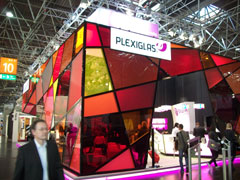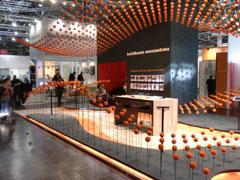
Top stories




EducationHow gender-inclusion in higher education can transform Africa’s future
Meekness Lunga-Ayidu 7 hours

LegalNigeria to implement new tax laws from January 1 despite calls for delay, Tinubu says
Camillus Eboh 2 days

"Euroshop is always a mind-blowing experience," says Justin Hawes, MD of Scan Display. "This year's show was bigger than ever before. Approximately 200 000 square meters of floor space was used in 13 halls. To give a comparison in terms of scale, Markex Jhb occupies roughly 10 500 square meters of (gross) floor space."
The Scan team noted that exhibition stands and retail displays at the show tended to incorporate either large curves or, conversely, very angular shapes. Texture was also explored through the use of layered materials, and sheer fabrics, string curtains and vertical tubes were used to create partial visibility through displays.

Fabric graphics are not new, having been introduced to the market some years ago. But Euroshop 2011 showed how they have been developed further. Sophisticated ways of joining fabric graphics have enabled the seams to be hidden, even on angular and awkwardly-shaped joins. This gives the display an overall smooth and neat look. "Fabric is very evocative and warm," adds Justin. "We wear it next to our skin, so it has connotations of comfort. The graphics printed on fabric also look warmer because of how fabric responds to light."

LED lighting has evolved to provide a wider range of solutions. It works well in a variety of contexts because it does not heat up, and the very small bulbs allow more control over how the light is dispersed through materials such as Perspex and fabric.
Exhibition stand lighting was predominantly suspended from rigging, as opposed to using long arms which attach to the structure - a method currently favoured in the South African market. Exhibition halls in Germany are geared for rigging, encouraging its use. Rigging gives greater scope when choosing how to light the stand, without obscuring any of its lines and graphics.

Euroshop was also the greenest it has been, as it featured energy-efficient fridges and more sustainable materials. Justin added that an interesting aspect to the exhibit halls, which could be considered green, is that the floors were painted instead of carpeted.
"South African exhibitions require large quantities of carpeting, which is both time-intensive to lay, and also tends to be wasteful as the carpet cannot be reused at another show. Black paint was used on the concrete floors at Euroshop, and it looked very smart."
The Scan Display team has returned from Euroshop feeling inspired with new ideas, products and business contacts. "The show is an invaluable experience, and we are excited to put our new discoveries into practice and take exhibitions in South Africa to the next level," says Justin.
Euroshop takes place over five days every three years, with this year's show running from 26 February to 2 March. The next show will be in 2014.
For more information about Scan Display, visit www.scandisplay.co.za or contact Justin Hawes on +27 11 447 4777 or az.oc.yalpsidnacs@nitsuj.